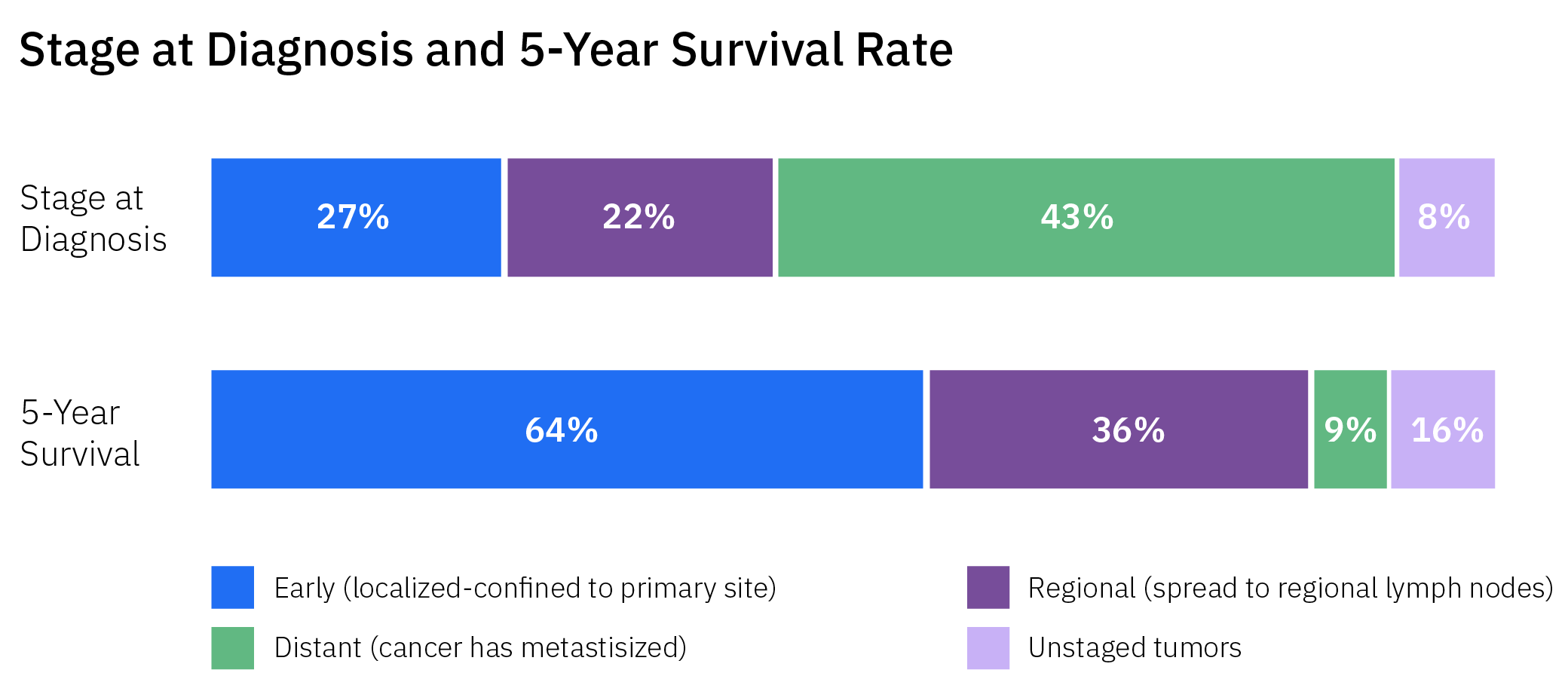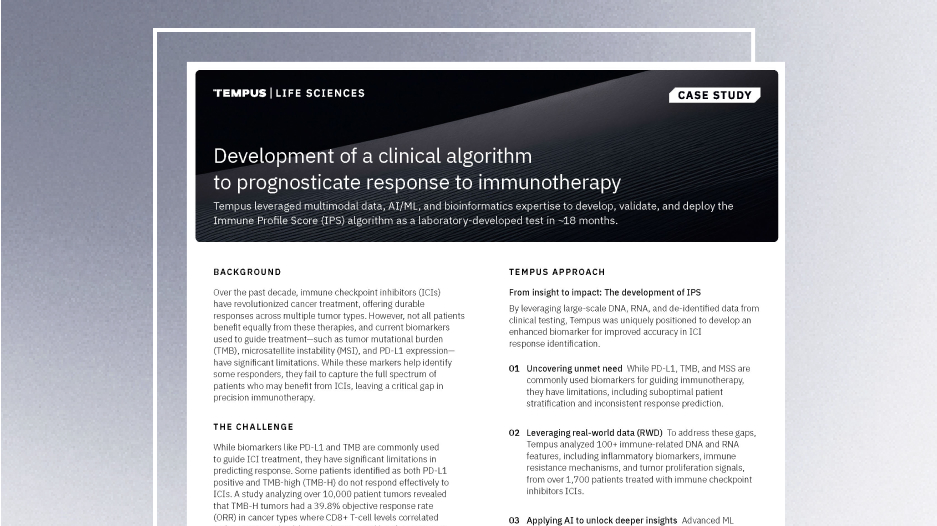-
PROVIDERS
Register now
Are you getting the full picture? A webinar series on the power of comprehensive intelligent diagnostics
-
LIFE SCIENCES
Enroll now
Tempus’ Patient-Derived Organoid ScreensEvaluate the efficacy of your preclinical compounds using fixed organoid panels designed for diverse therapeutic applications. Space is limited — enroll by June 30, 2025, to secure your spot.
-
PATIENTS
It's About Time
View the Tempus vision.
- RESOURCES
-
ABOUT US
View Job Postings
We’re looking for people who can change the world.
- INVESTORS
04/10/2025
Q&A: Advancing early detection in lung cancer: The role of incidental pulmonary nodules
Insights into the impact of IPN management on patient outcomes
Authors
Chiranjiv Singh
VP & GM, Pixel, Tempus

VP & GM, Pixel, Tempus

Introduction
Lung cancer is the leading cause of cancer-related mortality in the United States, with a five-year survival rate of just 28.4% due to late-stage diagnosis in most cases.1 Despite the availability of precision treatment options, lung cancer is often diagnosed too late for patients to be cured. Low-dose computed tomography (LDCT) is the primary method for lung cancer screening, yet it is underutilized, with only 16.0% of eligible individuals screened in 2022.1 Incidental pulmonary nodules (IPNs) found during imaging for other medical concerns present an alternative route for detecting early-stage lung cancer. The complexities of IPN detection and management are considerable, but digital technologies may offer solutions to improve these processes. This Q&A article explores the importance of IPNs in lung cancer care and how effective management can contribute to earlier diagnoses and improved outcomes for patients.
What is an incidental pulmonary nodule (IPN)? |
An incidental pulmonary nodule (IPN) is a small lung growth found unexpectedly during imaging tests not intended for lung cancer screening. For example, cardiac CT scans aimed at detecting coronary artery disease may incidentally reveal pulmonary nodule(s). IPNs can also be detected during routine chest imaging for preoperative evaluations, trauma assessments, evaluation for pneumonia or other lung infections, or abdominal scans. These nodules are usually less than 3 centimeters in diameter and can indicate various conditions, ranging from benign conditions to malignant early stage lung cancer. |
Why is IPN detection important in lung cancer care? |
Detecting lung cancer early is vital for improving patient outcomes. The five-year survival rate for lung cancer diagnosed at an early stage is around 60%, yet only 27% of lung cancer cases are identified early.1 In contrast, 43% of cases are diagnosed at a late stage, where the five-year survival rate drops to just 9%.1 Prompt identification and management of IPNs can increase the likelihood of early detection of lung cancer and intervention, which may greatly enhance the likelihood of successful treatment and increase survival rates. |
Figure 1 Stage at Diagnosis and 5-Year Survival Rate1

What are the guidelines for managing IPNs? |
The management of incidental pulmonary nodules (IPNs) follows evidence-based guidelines that help evaluate the risk of malignancy. These guidelines, provided by the Fleischner Society and the American College of Chest Physicians, recommend a detailed assessment using criteria such as nodule size, shape, growth rate, and patient-specific factors like age, smoking history, and additional lung cancer risk factors.2For nodules considered low-risk, guidelines advise a watchful waiting approach with regular imaging to track changes. Conversely, nodules with a higher risk of malignancy may require immediate, comprehensive diagnostic tests, including follow-up CT scans, PET scans, and possibly biopsy procedures.2 These guidelines are essential for healthcare providers to determine the most suitable and effective management plans for IPNs. |
What challenges arise in detecting and managing incidental pulmonary nodules (IPNs)? |
Detecting incidental pulmonary nodules (IPNs) presents several challenges. Often, these nodules are overlooked, especially when imaging exams are interpreted by non-thoracic radiologists. Research indicates that up to 64% of detected nodules are not followed up on, resulting in delayed diagnoses and worse outcomes for patients.3 While most nodules are benign, approximately 1.5% may be indicative of lung cancer, potentially leading to an estimated 63,000 new lung cancer diagnoses in the U.S. within two years of detection.4 Once an IPN is identified, adhering to management guidelines is challenging. Approximately 2 out of 3 patients with IPNs do not seem to receive a proper radiological and clinical follow-up. The standard recommendation for low-risk IPNs is periodic monitoring with follow-up scans. However, this can result in care gaps, as individuals with IPNs often lack the structured follow-up care that cancer patients receive. This absence of a systematic follow-up process can lead to missed scans, delaying cancer diagnosis and treatment.5 Additionally, the management process is complicated by the invasive nature of biopsies and the need to weigh the risks and benefits of such procedures for nodules with suspicious features.Effective IPN management demands compliance with evidence-based guidelines and a healthcare system that facilitates continuous care for these patients. The challenge is not only in detection but also in ensuring a thorough, multidisciplinary approach to diagnosis, risk assessment, and care coordination. |
Conclusion
The management of incidental pulmonary nodules (IPNs) is a complex element of lung cancer care, demanding a tailored approach based on individual patient factors and adherence to established guidelines. Tempus is at the forefront of creating tools that not only detect and characterize IPNs but also provide timely, individualized care navigation alerts to clinical teams overseeing nodule programs within health systems. Our strategy integrates clinical and radiology imaging data, employing advanced AI tools to pinpoint the most actionable cases, helping patients receive guideline-recommended care when it’s most appropriate. This method aims to refine IPN management by prioritizing patients in need of immediate care while providing information that may help to inform and avoid unnecessary procedures for others. Through enhancing the detection and assessment process, healthcare providers can better diagnose lung cancer early and improve patient outcomes.
Learn more about how Tempus Next can help your practice close gaps in care. Contact us to get started.
1. American Lung Association. (2024). State of Lung Cancer. Retrieved from https://www.lung.org/getmedia/12020193-7fb3-46b8-8d78-0e5d9cd8f93c/SOLC-2024.pdf
2. MacMahon, Heber, et al. “Guidelines for management of incidental pulmonary nodules detected on CT images: from the Fleischner Society 2017.” Radiology 284.1 (2017): 228-243.
3. Pyenson, Bruce S., et al. “No apparent workup for most new indeterminate pulmonary nodules in US commercially-insured patients.” Journal of Health Economics and Outcomes Research 6.3 (2019): 118.
4. Lung Cancer Policy Network. 2024. Enhancing the earlier detection of lung cancer: effective management of incidental pulmonary nodules. London: The Health Policy Partnership
-
04/02/2025
Development of a clinical algorithm to prognosticate response to immunotherapy
Discover how Tempus developed and deployed the Immune Profile Score (IPS)—a powerful algorithm that provides prognostic insights into patient outcomes following treatment with immune checkpoint inhibitors (ICIs)—in ~18 months. This case study highlights the AI-driven methodology, real-world validation, and the impact of IPS in precision oncology.
Read more -
03/25/2025
AI & ML in action: Unlocking RWD with GenAI through Tempus Lens
Discover how Tempus is equipping researchers with innovative AI solutions to fully leverage the potential of multimodal data. Gain insights from a panel of leaders across healthcare and life sciences as they discuss the impact of these advanced tools on delivering insights with speed.
Watch replay
Secure your recording now. -
03/11/2025
Case Report: Pharmacogenomic testing and mood stabilizers
This real-world case demonstrates how the Tempus nP pharmacogenomic test facilitated a personalized treatment approach for a patient with bipolar disorder.
Read more


